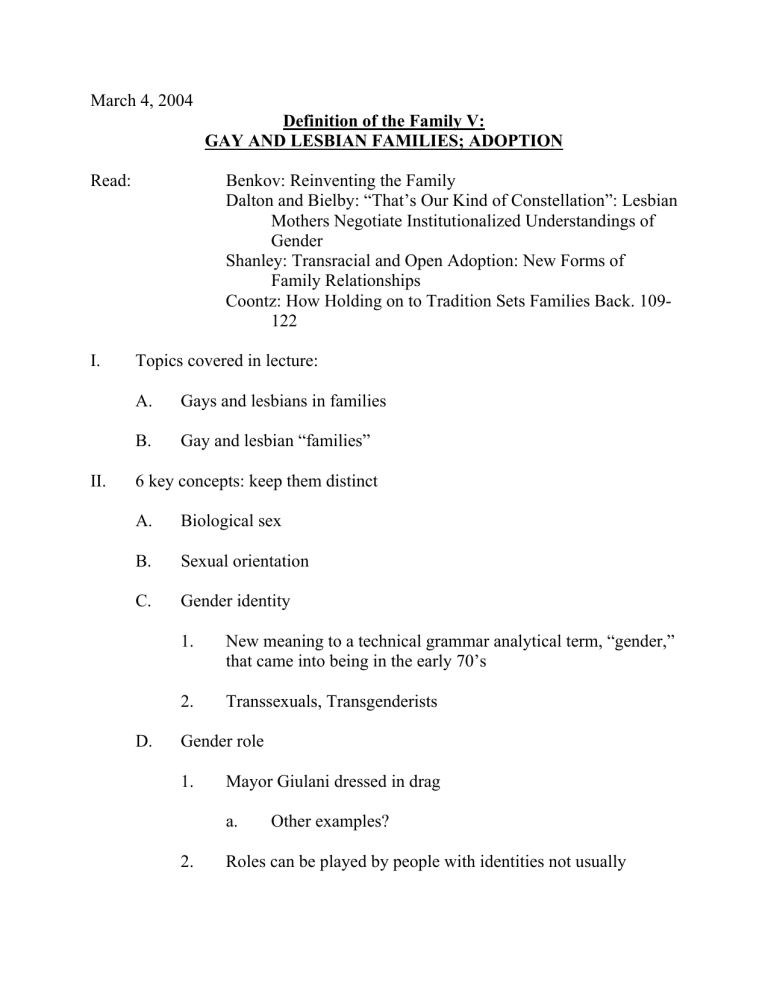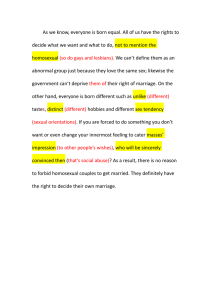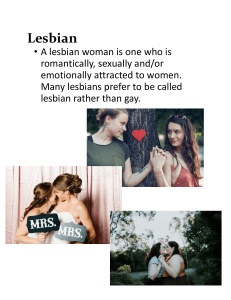
March 4, 2004 Definition of the Family V: GAY AND LESBIAN FAMILIES; ADOPTION Read: I. II. Benkov: Reinventing the Family Dalton and Bielby: “That’s Our Kind of Constellation”: Lesbian Mothers Negotiate Institutionalized Understandings of Gender Shanley: Transracial and Open Adoption: New Forms of Family Relationships Coontz: How Holding on to Tradition Sets Families Back. 109122 Topics covered in lecture: A. Gays and lesbians in families B. Gay and lesbian “families” 6 key concepts: keep them distinct A. Biological sex B. Sexual orientation C. Gender identity D. 1. New meaning to a technical grammar analytical term, “gender,” that came into being in the early 70’s 2. Transsexuals, Transgenderists Gender role 1. Mayor Giulani dressed in drag a. 2. Other examples? Roles can be played by people with identities not usually 2 associated with those roles E. F. Structural gender 1. Think of male dominance in the House of Lim 2. Holding the door open for “ladies” marks gender dominance, marks class as well Gender symbolism 1. III. Examples? On to homosexuality A. Traditionally defined in N. Europe and N. America as individuals who are attracted to individuals of the same sex; also called sexual orientation 1. Used to be called “inverts” and was defined very much in terms of gender role a. 2. Male inverts were effeminate; female inverts were masculine Transsexuals are not homosexuals a. Jan Morris, who used to be James Morris, is a wellknown writer b. Wrote a book called Conundrum c. He/she wasn’t gay or lesbian. Wanted to turn into the opposite sex and have a “straight” marriage 1 3. 1 Anthropology has a video “You don’t know Dick” about women who became men with sex-change operations Jan Morris, 1974. Conundrum. New York: Harcourt Brace Jovanovich, Inc. 3 B. a. Some of these men are heterosexual, some homosexual b. A good illustration of the independence of biological sex, gender identity, and sexual orientation c. We need to distinguish between transsexual, transvestite, homosexual, heterosexual, gay, lesbian 1) And new term “transgender” 2) Clearly, these terms have changed in meaning over time Cross-cultural variability 1. Highland New Guinea: among the Sambia male homosexual behavior occurs at 2 stages in life: a. b. As boys, they receive semen from oral sex from young men which is necessary to turn them into men 1) In secret, highly elaborate ceremonies 2) Later on, as youths they are the ejaculators As men all of them take wives and father families 1) c. Any type of homosexual desire or behavior is frowned upon The symbolism of the system is logical 1) Illustrates that societies use sex for non-sexual ends 2) In this case, to achieve full masculinity 3) What better symbol of masculinity than semen? 4 4) 2. What do some gay activists do with these data? a. If they assume that there are homosexuals everywhere, albeit closeted (even to themselves) because of cultural programming 1) b. C. Feeding, nourishing, to help the immature become mature is a very widespread symbol Then the New Guinea material is very problematic In Latin America, studies of “homosexuales” indicate that they report feeling feminine from very early on 1) Fully accept the traditional gender role ideology 2) “Homosexuals” are only those who take the passive role in sexual intercourse 3) Men who take the active role do not consider themselves, and are not considered by others, to be “homosexual” but rather “hombre-hombre”—very masculine 4) Unlike USA and N. Europe, in Latin America what defines “homosexuality” is not the object of desire, but the type of behavior itself History 1. Before the turn of the century, while there certainly was homosexual behavior, there was not what we would call homosexual lifestyle or identity 2. People were pressured to get married much more than today a. There was no space—cultural, social, even geographical—for openly being gay or lesbian as an 5 identity b. Of course there were individuals who knew they were entirely same-sex identified with regard to sexual desire 1) Society recognized this to some extent a) Usually negative 1) In Britain, Oscar Wilde, Radclyffe Hall famous individuals with same-sex orientation 19th century 2) In this country, the example of “Boston marriages” 19th century occurring between 2 upper class women a) In the upper class meant didn’t need to be married in order to survive economically b) However, genital sexual interaction was not always implied by this phrase c) If you’re defined by society as asexual, you very probably will define yourself this way as well—to some extent d) We don’t have any information about genital sexual behavior, but these women were certainly passionate about each other e) Their letters read like love letters f) We cannot conclude that they fit into our categories of gay/lesbian g) These categories refer to identity, a kind of identity not socially and culturally available at that time 6 3. But now, people can choose to live outside of conventional families all their lives and survive economically a. 4. Before, only rich people could do so with any degree of comfort and self-esteem, like couples in Boston marriages Thus there is an important difference in meaning between a collective identity of “being gay” a. And an individual’s own identity, which includes knowing something about one’s own sexual orientation 1) b. Maybe some others know it, maybe not J. Edgar Hoover, director of the F.B.I., is a good example 1) Everyone “knew” he was a homosexual, and some even knew he liked to cross-dress 2) But he most definitely was not “out” a) Ironic, because he was so powerful in part because of all the “dirt” his men acquired on important people, some of it information about their secret same-sex sexual activities b) Threats to reveal it were very effective in getting these people to do what Hoover wanted c. The film The Crying Game involves a cross-dressing demi-monde young man who fools a heterosexual Irishman for a while d. Films about gayness and gender bending have multiplied 1) Examples? 7 D. A great deal more cultural openness about gender bending exists today 1. E. The issue of bisexuality is seldom addressed; you are one or the other in mainstream American thought 1. IV. Explosion of books in anthropology, sociology, cultural studies Actually a continuum: some people are totally heterosexual or homosexual; others are bisexual Lesbians and gays in families A. Lesbians and gays today have options, institutions, meanings not available at earlier times 1. Now they have a one-in-four chance of being accepted 2. Earlier very few came out; when their sexual orientation was discovered, they were subjected to institutionalization, imprisonment, blackmail, loss of jobs, electroshock therapy 3. Coming-out stories reveal the position they still find themselves in with their families 4. a. They express notions about deception, about intimacy, about being loved “for what you are” b. Versus fears about rejection, hurting those you love, giving them heart attacks, etc. These stories reveal ideas about causes that are presently circulating a. “Don’t associate with those kinds of people”—it’s catching b. “You’re just willfully evil” 8 c. Being gay reflects poorly on parents because of the idea that bad childrearing explains why people are gay d. What does cause homosexuality? 1) III. Many lesbians and gays in this country portray their sexual identities as either inborn or a predisposition that developed very early in life a) Why, do you think? b) Especially given the evidence that many people are attracted to both men and women Lesbian and gay “families” A. B. One researcher, Weston, explores what family means to gays and lesbians who form families 1. Defined by blood, and feelings: relationship-building 2. There are ethnicity variations Benkov’s and Dalton and Bielby’s research teaches us how the concept of American family is contested 1. Just like the article on divorce in the colonial period, their research provides a source of information about “family” a. 2. Remember: studying deviance—situations where what ought to happen doesn’t—always tells us a lot about what members of a culture feel ought to happen Anthropologist David Schneider outlines his take on the assumptions underlying our concept of “family” a. Nature: notions about “shared substance,” of blood b. And the order of law, based on a customary “code for 9 conduct” 3. Some lesbians and gays feel they cannot create real families because families are “blood” a. And some rejected the idea for political reasons: seeing the establishment of gay families as an oppressive accommodation to a heterosexual society 4. But as we are seeing daily, many gays and lesbians want to create families, want to be legally married 5. Why? a. Material benefits b. Want the legal or, at least, social and public recognition of their relationship from their community, their society c. Want to create ceremonies, family rituals, etc., and find this more easy if they are within a marriage d. Want to avoid being reduced to someone who is seen in terms of sexual identity (or in terms of sexual behavior) alone 1) 6. In the 1960s and 1970s the gay rights movement and women’s movement: e. B. Want to be seen as people who work, who are active in the community, who have families Tended to see families as part and parcel of an oppressive society Today we see various campaigns: marriage, adoption options


